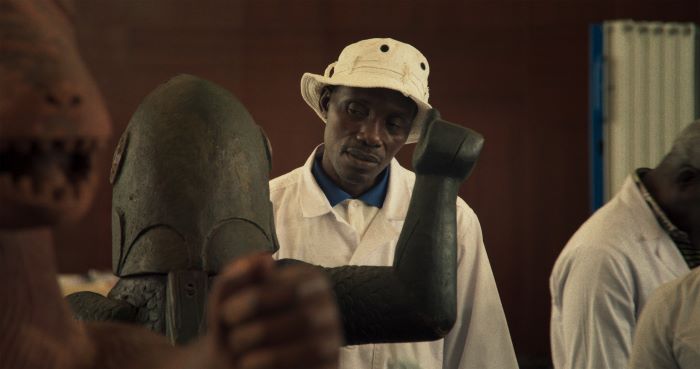In November 2021, 26 artifacts from the Kingdom of Dahomey (in what is now part of the Republic of Benin) were returned to Benin after having been taken by French troops in 1892, following the 1890 war between France and Dahomey. Over the course of the ensuing century, the artifacts made their way into the collections of various French museums, from the Musée de l’Homme to the Musée du Quai Branly. It wasn’t until nearly a century after the Dahomey artifacts were seized that the discussion of their repatriation began in the 1980s, when Pierre Quoniam wrote a report considering the possibility of their return.
This action remained an open possibility until 2016, when Patrice Talon, the president of the Republic of Benin, formally requested that the French government return the artifacts. Finally, in 2020, a motion calling for restitution passed in the French National Assembly, stipulating that by 2021 all of the works would be returned. Dahomey, structured as a documentary following the process of repatriation, engages intelligently and powerfully with a far grander narrative, delving into the history of the artworks and raising questions about the context of their return and also about their significance in the present.
The Musée du Quai Branly’s security camera footage captures the preparation of the 26 royal treasures as they are packed into shipping boxes. The sense of bureaucracy and objectivity here is interrupted by the poetic yearnings of a statue representing King Ghezo of Dahomey, who ruled from 1818 to 1858. We hear (but do not see) the statue speak throughout the film, recalling the taste of the sea in his hometown, Abomey.
The scene then shifts to the morning in Cotonou, Benin, after the artifacts have arrived. The locals dance joyously in traditional clothing, celebrating the installation of the objects with a grand ceremony. In contrast to this celebratory mood, the next sequence cuts to a debate at the University of Abomey-Calavi. There is an organic flow to the way the students there share their varying opinions, from which Diop patterns a narrative of postcolonial sentiment among Benin’s youth. These scenes are engaging and true to the spirit of debate. One student argues that culture consists of both material and immaterial realms—statues and folklore—and that focusing on repatriation should not be the main concern when the immaterial makes up most of a culture.
Formally, the film is heavily reminiscent of the 1953 documentary short “Statues Also Die” by Chris Marker, Alain Resnais, and Ghislain Cloquet, which sought to answer the question: “Why is Black African art located in the Musée de l’Homme, whereas Greek or Egyptian art is in the Louvre?” In its time, “Statues Also Die” was revolutionary for confronting Western colonialism’s reduction of African art to mere ethnographic objects, compounding the insult of looting by marginalizing the position of Africans in the world and diminishing the aesthetic achievements of their art.
In Dahomey, Diop manages to bridge realms through her filmmaking, giving the statues their own living voices reciting poetry in their native language, in a way welcoming them back into their culture. Much like her previous film Atlantics, she builds visual poetry even in the midst of a century-long debate. Meanwhile, dreamlike music by Dean Blunt and Wally Badarou accompanies the hopeful faces of museumgoers welcoming back their ancestors, as well as the lively nights of Cotonou, along the beach that the artifacts have longed to return to for years. Poetic narrative and documentary are interwoven, with the talking statue serving as the voice for a people who have longed to be reunited with pieces of their culture.
Mati Diop has created a film that is visually powerful and deeply engaged in the political discourse of the postcolonial age. What might appear from a summary to be a straightforward documentary about a recent political event is, in fact, a deeply poetic story that touches on space, time, memory, colonialism, and the possibilities of the future, all within the span of just over an hour.







Leave A Comment